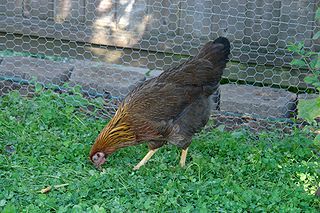
The Welsummer or Welsumer is a Dutch breed of domestic chicken. It originates in the small village of Welsum, in the eastern Netherlands. It was bred at the beginning of the twentieth century from local fowls of mixed origin: Rhode Island Reds, Barnevelders, Partridge Leghorns, Cochins, and Wyandottes. In 1922–23, steps were taken to fix a standard after the birds began to show a good deal of uniformity. The eggs were originally exported for the commercial egg trade. Some stock was exported to the United Kingdom, and the breed was added to the British Standard in 1930.

The Chinese is an international breed of domestic goose, known by this name in Europe and in North America. Unlike the majority of goose breeds, it belongs to the knob geese, which derive from Anser cygnoides and are characterised by a prominent basal knob on the upper side of the bill. It originates in China, where there are more than twenty different breeds of knob goose.

The Orpington is a British breed of chicken. It was bred in the late nineteenth century by William Cook of Orpington, at that time in Kent in south-east England. It was intended to be a dual-purpose breed, to be reared both for eggs and for meat, but soon became exclusively a show bird. The Australorp of Australia derives from it.

The Cochin is a breed of large domestic chicken. It derives from large feather-legged chickens brought from China to Europe and North America in the 1840s and 1850s. It is reared principally for exhibition. It was formerly known as Cochin-China.

The Indian Game is a British breed of game chicken, now reared either for meat or show. It originated in the early nineteenth century in the counties of Cornwall and Devon in south-west England. It is a heavy, muscular bird with an unusually broad breast; the eggs are brown.

The Australorp is an Australian breed of dual-purpose utility chicken. It derives from the British Black Orpington, and was selectively bred for egg-laying performance; some hens lay more than 300 eggs per year. It achieved world-wide popularity in the 1920s after the breed broke numerous world records for number of eggs laid and has been a popular breed in the western world since. It is one of eight poultry breeds created in Australia and recognised by the Australian Poultry Standards. The original plumage colour is black, which is the only colour recognised in the United States of America, but blue and white are also recognised in Australia and the Poultry Club South Africa recognises buff, splash, wheaten laced and golden in addition.

The Sussex is a British breed of dual-purpose chicken, reared both for its meat and for its eggs. Eight colours are recognised for both standard-sized and bantam fowl. A breed association, the Sussex Breed Club, was organised in 1903.
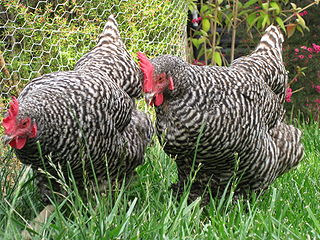
The Plymouth Rock is an American breed of domestic chicken. It was first seen in Massachusetts in the nineteenth century and for much of the early twentieth century was the most widely kept chicken breed in the United States. It is a dual-purpose bird, raised both for its meat and for its brown eggs. It is resistant to cold, easy to manage, and a good sitter.
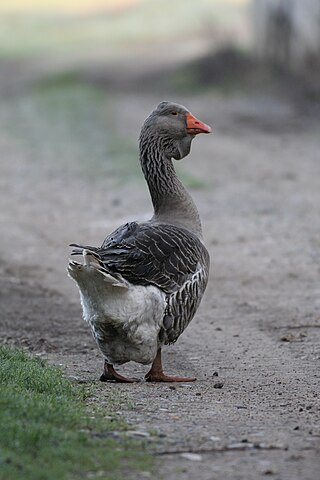
The Toulouse is a French breed of large domestic goose, originally from the area of Toulouse in south-western France. Two types are recognised: a heavy industrial type with dewlaps, the French: Oie de Toulouse à bavette; and a slightly lighter agricultural type without dewlaps, the French: Oie de Toulouse sans bavette. Both types are large, with weights of up to 9 kg. Birds bred in the United Kingdom and United States exclusively for showing may be still larger, and have a somewhat different conformation.

The Emden or Embden is a German breed of domestic goose. It is named for the town of Emden in north-westernmost Germany.

The New Hampshire Red or New Hampshire is an American breed of chicken. It was developed in the early twentieth century in the state of New Hampshire by selective breeding of Rhode Island Red stock; no other breed was involved. It is fast-growing, early-maturing, quick-feathering, and yields a meaty carcass. Mature birds are a light or medium red in color; they may fade in sunlight.
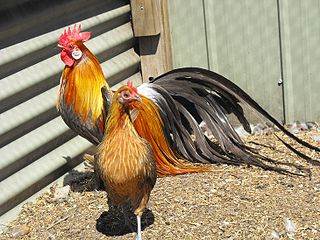
The Phoenix is a German breed of long-tailed chicken. It derives from cross-breeding of imported long-tailed Japanese birds similar to the Onagadori with other breeds.
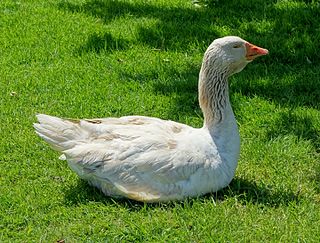
The American Buff is an American breed of domestic goose. It was accepted by the American Poultry Association in 1947. It is named for its single plumage variety, which is a pale buff or apricot-fawn in color.

The Magpie is a British breed of domestic duck. It has distinctive black and white markings reminiscent of the European magpie, and is a good layer of large eggs.

The Ancona is a breed of domestic duck, characterised by an unusual and variable broken-colored plumage pattern. It is not clear whether it originated in the United Kingdom or in the United States. It is not recognised or listed by the American Poultry Association, by the Entente Européenne d'Aviculture et de Cuniculture, or by the Poultry Club of Great Britain.

The Saxony is a German breed of domestic duck. It was bred in Saxony in the 1930s, but because of the Second World War was recognised only in 1957.
The Vištinės or Vishtines is a Lithuanian breed of domestic goose. It was developed by selective breeding of traditional Lithuanian geese, with some later influence from the East Prussian, Emden and Pomeranian breeds.

The Niederrheiner is a German breed of chicken. It is named for the Niederrhein or Lower Rhine region where it originated in the early twentieth century, and derives principally from the Dutch North Holland Blue meat chicken. It was recognized in Germany in 1943. In the twenty-first century it is an endangered breed.

The Appenzeller Barthuhn is a Swiss breed of bearded chicken originating in the historical Appenzell region of Switzerland. It is one of two chicken breeds from that area, the other being the Appenzeller Spitzhauben; the only other Swiss breed of chicken is the Schweizer.



















